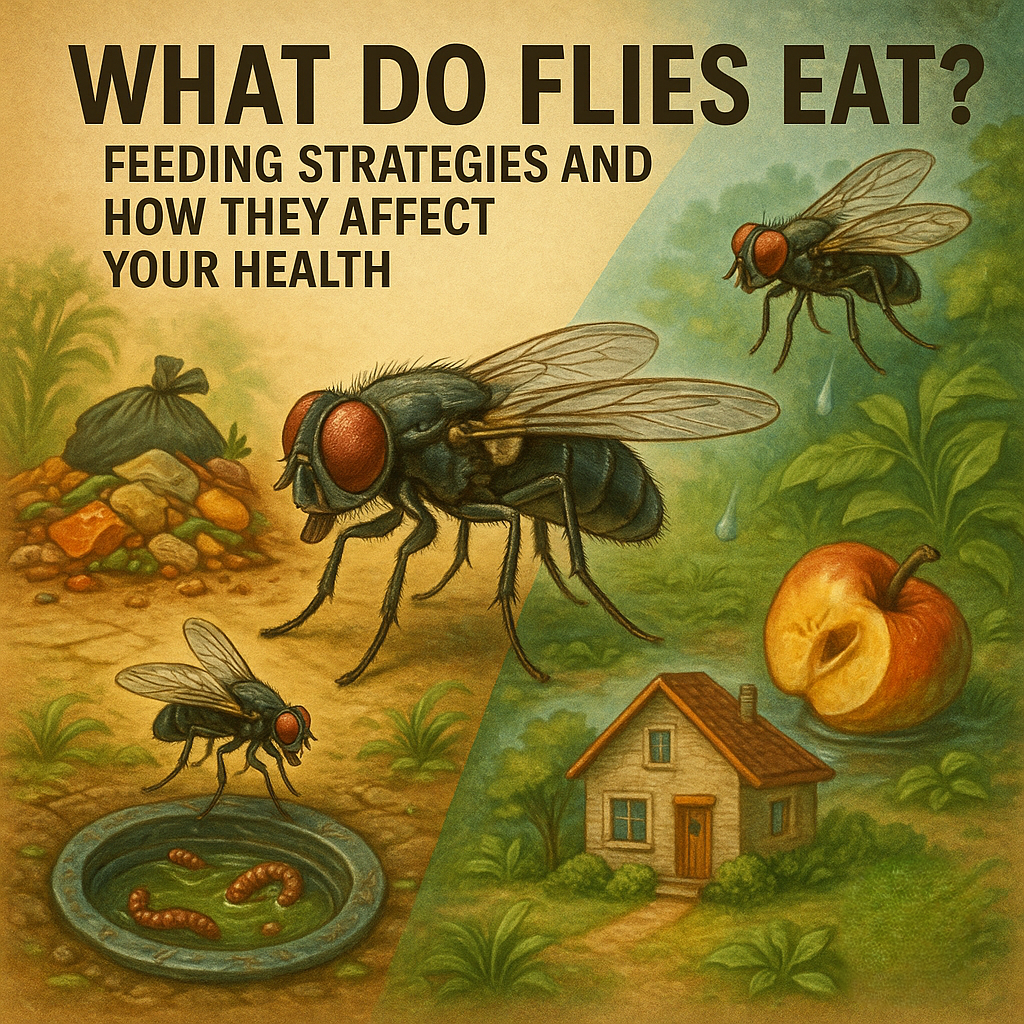
From natural recyclers to disease carriers: discover their habits and how to manage them
When a fly lands on your food, the first reaction is usually to shoo it away in disgust. But behind that instinctive gesture lies a fascinating biological phenomenon. Flies, in addition to being one of the most common urban pests, represent a group of insects with highly specialized feeding strategies, making them both allies of the ecosystem and potential sanitary threats.
In this article, we explore the types of fly feeding habits, how they relate to their ecological role, why some species are harmless while others are vectors of disease, and how we can manage their presence in a responsible and effective way.
Dietary Diversity in the Order Diptera
Flies belong to the order Diptera, which includes more than 150,000 described species. This enormous diversity is also reflected in a wide variety of feeding habits. Depending on their diet, flies can be grouped into several functional types:
🔹 Saprophagous: Feed on decomposing organic matter (e.g., Musca domestica).
🔹 Hematophagous: Feed on blood (e.g., Stomoxys calcitrans, Glossina spp.).
🔹 Frugivorous/Nectarivorous: Consume nectar or fermented fruits (e.g., Drosophila, Eristalis spp.).
🔹 Parasitoid/Predatory: Some Tachinidae species lay eggs in other insects.
This dietary spectrum explains why flies are found on fruit, garbage, open wounds, flowers, stables, and forensic laboratories.
Saprophagous Flies: Natural Decomposers and Urban Risks
Saprophagous species like the house fly (Musca domestica) play a fundamental role in the decomposition of organic waste. In both larval and adult stages, they break down rotting fruit, feces, and carcasses, recycling nutrients that enrich the soil.
However, their ability to visit putrid material and then land on human food makes them vectors of bacteria such as Salmonella, E. coli, or Shigella. This dual function—ecological and pathogenic—is a clear example of how the environment determines whether a fly is an ally or a threat.
Hematophagous Flies: Tiny Vampires with Pathogenic Load
Hematophagous species have evolved specialized mouthparts to pierce skin and extract blood. Some of the most relevant include:
🔹 Stomoxys calcitrans (stable fly): Affects livestock, reducing productivity.
🔹 Glossina spp. (tsetse fly): Transmits African trypanosomiasis or “sleeping sickness”.
🔹 Midges and blackflies: Found in tropical climates, capable of transmitting diseases such as onchocerciasis.
These flies are examples of how feeding behavior becomes a direct pathway for pathogen transmission, affecting both humans and domestic or wild animals.
Frugivorous and Nectarivorous: Harmless or Intrusive?
Flies like Drosophila melanogaster (fruit fly) are common in kitchens and markets. They feed on sugars and fermented fruits and don’t pose a major health risk, but their proliferation can affect the quality of food products and become a pest.
On the other hand, species such as Eristalis spp. (drone flies) are accidental pollinators, and while often overlooked, they play an important role in agricultural and natural ecosystems.
What Attracts Flies to Our Spaces?
Flies have an extremely sensitive sense of smell for volatile compounds such as alcohols, fatty acids, amines, and fermented sugars. This draws them to:
- Poorly sealed garbage bins
- Drains and sumps
- Ripe or rotting fruits
- Organic waste in kitchens and yards
The accumulation of this waste activates their reproductive instincts, causing infestations if not addressed in time.
Sustainable Coexistence and Smart Control
At Eco Fauna Control, we believe that managing flies is not about indiscriminate eradication, but about keeping their population at levels compatible with human health and ecological balance.
That’s why we offer specialized solutions that include:
🔬 Professional diagnosis: We identify the species, its life cycle, and food source.
🧪 Integrated Pest Management (IPM): We combine physical, biological, and chemical methods responsibly.
🌿 Sustainable solutions: We reduce insecticide use to the minimum necessary.
📊 Monitoring and prevention: We detect conditions favorable to their reproduction and help you avoid them.
Our plans are tailored to private homes as well as businesses, restaurants, food industries, or farms, ensuring an effective and environmentally respectful response.
Conclusion: Pests or Key Ecosystem Players?
Flies have evolved to colonize almost any environment thanks to their dietary and reproductive adaptability. Understanding what they eat and how they do it allows us to:
- Appreciate their role in organic matter degradation and pollination
- Prevent their role as vectors of disease
- Apply responsible and sustainable control strategies
At Eco Fauna Control, we support an integrated vision: to protect human health while also preserving essential ecological processes. If you are looking for a professional and eco-friendly solution for fly management, contact us!
